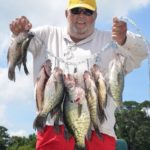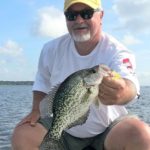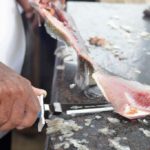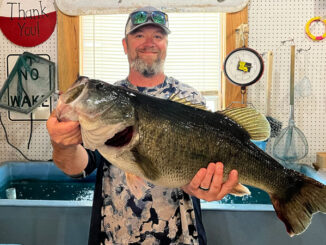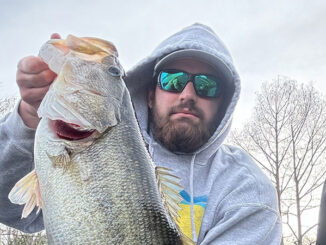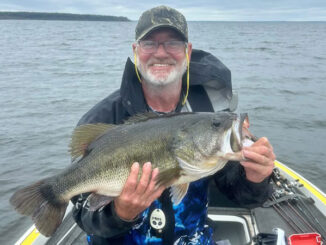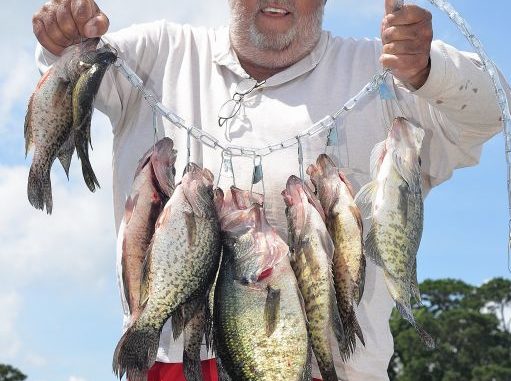
Want to catch crappie every day, even when temperatures sizzle the waters of Toledo Bend? Just follow the advice of this proven perch jerker.
Toledo Bend has been on an amazing run lately, producing numbers of double-digit bass.
But that’s not the only fish swimming in this huge reservoir. No, crappie literally swarm in the Bend, and they grow to whopper sizes.
In fact, it’s not unheard of for crappie to average 1 1/4 pounds. Put together a limit of those, and ice chests fill quickly.
So, then, do you want to eat hefty slabs of the tastiest flesh ever to lay upon the sides of any freshwater fish in Louisiana?
Then load the boat, the family and/or friends to spend some time at Toledo Bend Reservoir this summer.
The wisdom of launching in the lake was illustrated this last summer when I headed out with longtime guide Maurice Jackson of Zwolle.
Jackson, Mister Twister’s Chuck Byrd and I set out into the 1215 area to fish some brush piles the guide had strategically set and arranged in the area.
“I found some here a couple of days ago,” the 68-year-old Jackson said while looking at his Lowrance.
The guide threw out a marker buoy, while we baited up with medium-sized shiners and a few tiny plastics.
It didn’t take long until Jackson and Byrd started hauling in fish — and some good ones.
There were many doubles.
“The fish are suspended in this brush pile at 18 feet,” Jackson said. “And there is a large group here.”
After placing a dozen fish over 10 inches in the cooler, the bite slowed and it was off to another tangle of structure farther south.
“This brush pile is a very special one,” Jackson said. “I hope those fish are here.”
Sure enough, after a few fish over a pound were taken, Jackson smiled when a very special slab appeared.
“This one will go near 2 pounds,” he said.
Byrd and I agreed, and the camera was put to work capturing the moment.
After 15 crappie were in the boat, Jackson caught another huge fish and Byrd hauled one in that looked to be over a pound.
“Maurice, you put us on some very good fish here,” Byrd said.
Eventually the big-slab brush pile played out.
So it was again off to another — at high noon.
“It’s hard to believe the crappie bite in the middle of the day,” Byrd said.
The guide wasn’t surprised at all.
“They sometimes bite better at midday,” Jackson said. “Just look around at all the bass boats and pontoons out there — they’re all catching crappie or they wouldn’t be here.”
From late April until the middle of the fall, Toledo Bend crappie gather around deep, submerged structure in strategic locations along the winding Sabine River channel, the interior guts of the reservoir.
The reason is pretty simple: Schools of baitfish seek the cover and forage these brush piles offer.
“The leaves of the trees that make up the brush piles have larvae still producing insects, which in turn attract small baitfish,” Jackson said.
According to Louisiana Department of Wildlife and Fisheries biologist manager Sean Kinney, there are two major species of baitfish upon which crappie forage.
“There’s plenty of forage for crappie in Toledo Bend,” he said. “They will target silverside minnows and threadfin shad.”
Making homes for that baitfish is something that takes work.
“I will have 110 tops set out in 15 to 25 feet of water at any given time along the channel,” Jackson said. “I will also reset them every year and make sure that they are brushed fully with green foliage.”
While many anglers and guides spend time creating personal brush piles, there are other options.
“There are 17 public, artificial reefs in Toledo Bend Lake,” Kinney said. “Some are better than others, but you can find panfish — including crappie — on many of them.
“The Eagle Scout reef near Pirate’s Cove Marina can be good in the late spring and early summer, but it eventually gets covered by hydrilla.”
There also are a number of public fishing locations at the midway point of the reservoir.
“Pilings 2 to 26 on the Louisiana side of the Pendleton Bridge were specifically designed to attract crappie, but anglers will also find white bass on them,” Kinney said. “There are some lighted reefs with illumination beginning at dark, and they remain lighted until daylight.
“They can be pretty productive, and anglers can usually find crappie during the summer on the deeper portions of these structures when the fish suspend there.”
The biologist said the reef named Megastructure No. 2 is also a very good one from which anglers have reported great catches of crappie in 20 feet of water.
The nearest launch to Megastructure No. 2 is at Kite’s Landing.
Other popular artificial reefs include North Toledo Bend State Park Reef No. 1 and North Toledo Bend State Park Reef No. 2.
Of course, electronic depth finders with GPS access are necessary to locate these reefs.
Once an angler nails down a reef, it takes some trial and error to figure out where the fish are concentrated.
“To find fish on these reefs, you should start by slowing dropping shiners or jigs down to find out at which depths the crappie are suspended in,” Jackson said. “If you reach bottom, you want to slowly come up with the baits until you start catching fish. Then you can estimate the depths of where they are suspended and drop your shiners or jigs in the same location.
“You’ll catch more crappie that way until that part of the structure plays out.”
Editor’s note: Maurice Jackson can be contacted at 318-645-6863 or 318-617-4887.
